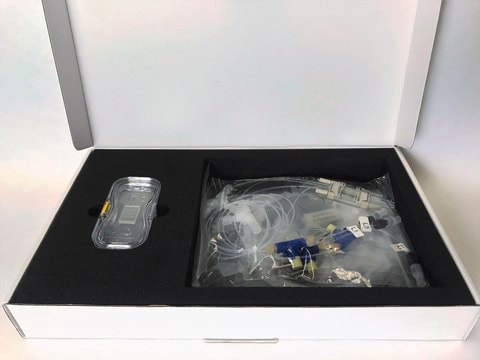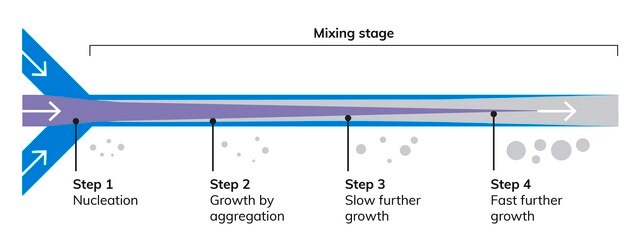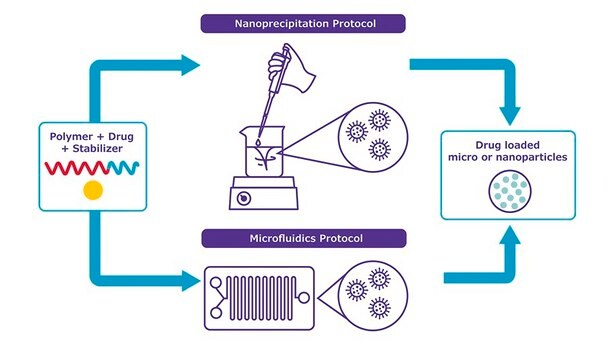おすすめの製品
詳細
Kit components :
PLGA-Nano (907782-500mg)
PLGA-Nano75 (916382-500mg)
PLA-Nano (910996-500mg)
PCL-Nano (916382-500mg)
Stabilizer - P (913448-10g)
品質水準
アプリケーション
advanced drug delivery
詳細
NanoFabTx™ formulation kits and lipid mixes enable users to encapsulate a wide variety of therapeutic drug molecules for targeted or extended drug delivery without the need for lengthy trial-and-error optimization. NanoFabTx™ kits provide an easy to use toolkit for encapsulating a variety of therapeutics in nanoparticles, microparticles, or liposomes. Drug encapsulated particles synthesized with the NanoFabTx™ kits are suitable for biomedical research applications such as oncology, immuno-oncology, gene delivery and vaccine delivery.
アプリケーション
The NanoFabTx™ materials screening kit, for synthesis of polymeric nanoparticles, is a ready-to-use nanoformulation kit for the synthesis of nanoparticles for drug delivery. Poly(lactic-co-glycolic acid) (PLGA), poly(D,L-lactic acid) (PLA) and polycaprolactone (PCL) are biocompatible and biodegradable polymers that have been approved by the FDA for biomedical and pharmaceutical applications. This kit includes properly selected PLGA, PLA, and PCL polymers and stabilizer, allowing for rapid screening of optimal materials for enhanced drug loading and controlled drug release.
特徴および利点
- Ready-to-use polymer drug formulation screening kit for non-PEGylated nanoparticles
- Choose from either nanopreciptiation or microfluidics-based protocols
- Create specifically sized, biodegradable, PLGA, PLA, or PCL nanoparticles
- Maximize the encapsulation of hydrophobic drugs
- Four different non-PEGylated polymers are included
調製ノート
Comprehensive protocols for nanoparticle synthesis methods are included:
The microfluidics protocol uses NanoFabTx™ device kits (911593), which provide the microfluidics chips, fittings, and tubing required to get started with microfluidics-based synthesis (compatible microfluidics system or syringe pump required).
For more information, please refer to the protocol under the document section of this page.
- A nanoprecipitation protocol to prepare drug-encapsulated nanoparticles in standard laboratory glassware.
- A microfluidics protocol using commercial platforms or syringe pumps.
The microfluidics protocol uses NanoFabTx™ device kits (911593), which provide the microfluidics chips, fittings, and tubing required to get started with microfluidics-based synthesis (compatible microfluidics system or syringe pump required).
For more information, please refer to the protocol under the document section of this page.
法的情報
NANOFABTX is a trademark of Sigma-Aldrich Co. LLC
保管分類コード
11 - Combustible Solids
WGK
WGK 3
適用法令
試験研究用途を考慮した関連法令を主に挙げております。化学物質以外については、一部の情報のみ提供しています。 製品を安全かつ合法的に使用することは、使用者の義務です。最新情報により修正される場合があります。WEBの反映には時間を要することがあるため、適宜SDSをご参照ください。
Jan Code
917737-1KT:
917737-VAR:
917737-1EA:
917737-BULK:
最新バージョンのいずれかを選択してください:
S Freiberg et al.
International journal of pharmaceutics, 282(1-2), 1-18 (2004-09-01)
Polymer microspheres can be employed to deliver medication in a rate-controlled and sometimes targeted manner. Medication is released from a microsphere by drug leaching from the polymer or by degradation of the polymer matrix. Since the rate of drug release
Verónica Lassalle et al.
Macromolecular bioscience, 7(6), 767-783 (2007-06-02)
The controlled release of medicaments remains the most convenient way of drug delivery. Therefore, a wide variety of reports can be found in the open literature dealing with drug delivery systems. In particular, the use of nano- and microparticles devices
Nazila Kamaly et al.
Chemical Society reviews, 41(7), 2971-3010 (2012-03-06)
Polymeric materials have been used in a range of pharmaceutical and biotechnology products for more than 40 years. These materials have evolved from their earlier use as biodegradable products such as resorbable sutures, orthopaedic implants, macroscale and microscale drug delivery
Byung Kook Lee et al.
Advanced drug delivery reviews, 107, 176-191 (2016-06-06)
Poly(d,l-lactic acid) (PLA) has been widely used for various biomedical applications for its biodegradable, biocompatible, and nontoxic properties. Various methods, such as emulsion, salting out, and precipitation, have been used to make better PLA micro- and nano-particle formulations. They are
ライフサイエンス、有機合成、材料科学、クロマトグラフィー、分析など、あらゆる分野の研究に経験のあるメンバーがおります。.
製品に関するお問い合わせはこちら(テクニカルサービス)



